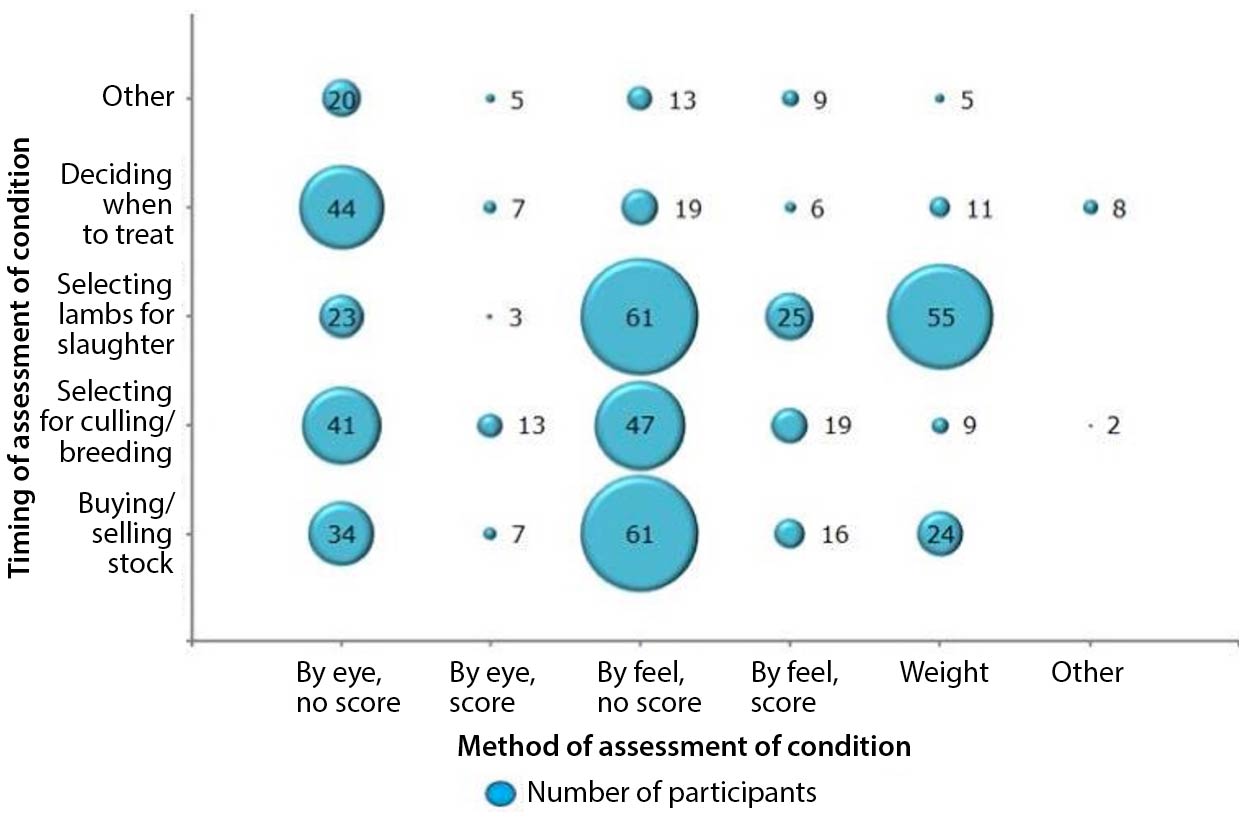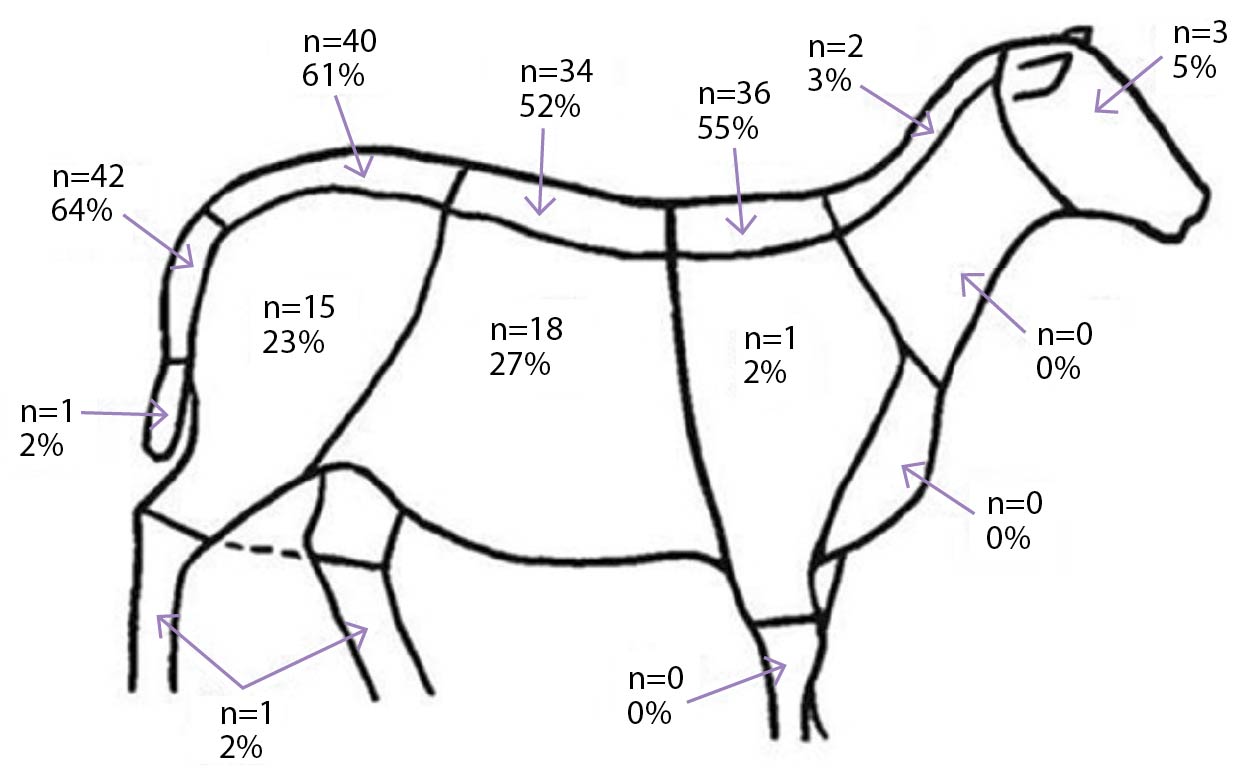6 Mar 2017
Ceri Owen, Nigel Kendall, Fiona Lovatt and Marnie Brennan reveal findings from a questionnaire into sheep farmers’ recognition and utilisation of body condition scoring.

Figure 2. Schematic diagram demonstrating points of palpation for condition assessment as indicated by 63 per cent of participating sheep farmers when asked to place a cross on a photograph (66/105).
Research has been limited into how body condition scoring (BCS) is understood and used by sheep producers. A questionnaire was conducted with 105 British sheep farmers – mainly at agricultural shows – focusing on the awareness and implementation of BCS, as compared to literature, during summer 2010.
Most participants (89%) stated they assessed the condition or fatness of their sheep; 81% responded they had heard of BCS. A large proportion of participants nominated using BCS (67%), but only 32% said they assessed condition score by palpation and applied an actual score. Selecting lambs for slaughter and trading stock were the most likely times participants nominated undertaking condition assessment. When asked to indicate the areas palpated when assessing body condition, most respondents nominated the tail region (64%). A range of methods were given when asked how body condition was categorised, with 29% of respondents categorising into three levels, 25% assigning a score between 1 and 5, and 19% categorising into two levels.
By gaining knowledge on how farmers assess the body condition of their animals, communication and training needs can be further targeted towards areas of uncertainty, leading to better productivity and welfare through nutritional management.
Body condition scoring (BCS) is the process of subjectively assessing flesh cover (Russel, 1984) used as a management tool in animal production systems.
Limited research has been conducted, especially in the UK, to consider the implementation of BCS by producers. This study looked at producer awareness of BCS and how they used condition scoring compared to recommendations in literature.

A questionnaire was designed and sheep farmers were approached at three agricultural events between July and September 2010 (the Great Yorkshire Show in Harrogate, the Royal Welsh Show in Builth Wells and the National Sheep Association Sheep Event in Malvern). The questionnaire underwent pre-testing and piloting phases prior to the final administration. Further questionnaires were given to participants in farmer discussion groups in north Wales during the same period.
The questionnaire was composed of 21 questions addressing basic farm information (for example, flock size and type as stated by participants), understanding of BCS (where the participant had learned of BCS and whether they used it), method and timing of condition assessment, and personal details (age, sex and level of educational qualification).
A prize draw for agricultural stockist vouchers was offered as an incentive. Data analysis was performed using Microsoft Excel and Minitab 15 statistical software. A Bonferroni correction was used to mitigate the effects of multiple testing (Dohoo et al, 2009), generating a p-value of 0.01 for statistical significance. Ethical approval was received from The University of Nottingham School of Veterinary Medicine and Science ethics research committee. Where questions were left unanswered by respondents, the number of respondents per question is identified.
A total of 105 participants completed the questionnaire (13 from farmer discussion groups), with 81% (82/101) of participants nominated hearing previously about BCS, with 19% (19/101) stating they had never heard of it. Younger participants below the age of 20 (p=0.005) and those with 50 ewes or fewer (p=0.003), and commercial farmers (p=0.03) were more likely to report they had heard of BCS.
Around 67% of participants (55/82) said they used BCS in their flock; participants on upland farms (p=0.01) were more likely to use BCS. Many respondents stated they had first learned about BCS through education (29/67, 43%) and/or companies and societies (for example, EBLEX, Meat and Livestock Commission), and breed societies (14/67, 21%).
Having been asked about their awareness of BCS, participants were then asked how they assessed the condition of their sheep in their own flocks. A total of 89% (89/100) of responding participants said they assessed the condition of their sheep. Of the 88 respondents that nominated how they assessed condition, most reported to do so by eye and feel without allocating a score, and by weighing animals (Figure 1). Most participants reported they assessed their sheep when selecting lambs for slaughter and when buying or selling stock.
To determine the areas palpated when assessing body condition, participants were shown a colour photograph of a sheep and asked to indicate locations felt or handled with a cross. The outline shown in Figure 2 was used to categorise the response areas and the number using each area is shown. Most respondents nominated the tail region (n=42, 64%), followed by palpation over the rump (n=40, 61%) and the shoulder area (n=36, 55%; Figure 2).

When asked how participants categorised body condition during assessment (n=51), 29% (15/51) categorised animals into three levels (fat, acceptable and thin), 27% (14/51) gave an answer not related to a specific scoring system, 25% (13/51) gave a score between 1 and 5, and 19% (10/51) categorised into two levels (middle/acceptable and thin/lean).
Many farmers considered they assessed the condition of their sheep, although few described themselves as assessing by palpation followed by giving a score (regardless of the time of year or animal’s age).
Assessment appears to be occurring in a variety of ways, with a small number doing so according to recommendations by industry bodies (Hybu Cig Cymru [HCC], 2006; EBLEX, 2009). This information is useful for other stakeholders, such as vets and industry bodies, as assumptions about how and when BCS is carried out could be incorrect. It appears as though assessment could be carried out primarily when there is the most direct economic impact for the farmers (Tribe and Seebeck, 1962; Gunn and Doney, 1975; Gibb and Treacher, 1980; Binns et al, 2002), as opposed to being used to assess general flock health across the year, which could have health, welfare and productivity implications (Kenyon et al, 2014; Beef and Lamb New Zealand, 2013).
Most participants reportedly palpated over the base of the tail, even though this is not specifically highlighted in general BCS recommendations (Jefferies, 1961; Russel et al, 1969; EBLEX, 2005; HCC, 2006), suggesting confusion with lamb assessment prior to slaughter. Most participants were recruited through sheep events, which could have affected the result obtained here (for example, method of stock judging). However, many people also palpated at the lumbar region, which is frequently recommended (Jefferies, 1961; Russel et al, 1969; EBLEX, 2009).
Participants most often categorised animals into three levels – other publications have also discussed the use of a similar
fit-fat-thin scoring system (Lovatt, 2010; Phythian et al, 2012). The three category system could translate directly into management changes (increased nutrition for lean animals, maintenance for average animals and decreased nutrition for fat animals). If the assessment systems used by farmers in this study translate to the wider sheep farming community, this could demonstrate more explanation needs to accompany advice given to farmers on BCS (EBLEX, 2005; HCC, 2006).
The limitations of this study include possible bias in the selection of participants and low response rates for some questions. Additionally, definitions of condition assessment were not provided and, therefore, misinterpretation by farmers is possible. It is also unknown how representative these participants are of sheep farmers across the UK and further afield.
It appears from this study that condition assessment is used in a variety of ways by producers, which is sometimes different to those endorsed by other industry bodies. Awareness of the uncertainties assists in the development of more targeted training programmes and will, ultimately, improve flock health and welfare.
Many thanks to the farmers who participated in this research and the organisers of the agricultural events for allowing us to conduct our survey. Many thanks also to The University of Nottingham for funding the research.